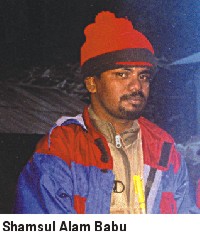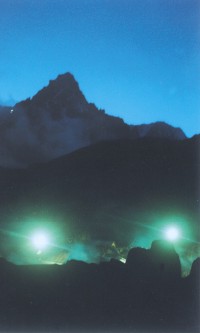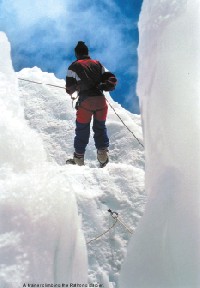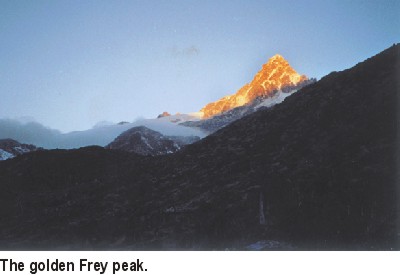|
Exhibition
Everest
Calling
A
pictorial odyssey of mountain life and landscape through a
would-be mountaineer's lens
Afsar
Ahmed
Any man
in his right mind would have said no. But M Shamsul Alam Babu
could not afford to say number For, in his heart, he felt
the pull of the Everest. It is so strong a force that he cannot
resist.
 "It
was back in 1986 when I first caught a glimpse of Sir Edmund
Hillary live at Dhaka Press Club, saying that it was really
astonishing that people from Bangladesh hadn't yet tried to
conquer Mt Everest, though it is quite near to the country.
And the words stayed in my mind. I decided that one day I
would ascend the highest summit of the world," says an
exultant Babu. "It
was back in 1986 when I first caught a glimpse of Sir Edmund
Hillary live at Dhaka Press Club, saying that it was really
astonishing that people from Bangladesh hadn't yet tried to
conquer Mt Everest, though it is quite near to the country.
And the words stayed in my mind. I decided that one day I
would ascend the highest summit of the world," says an
exultant Babu.
Everest
seems to attract a lot of people. Ones who go near it to savour
the beauty and ones who dream to lodge their feet on its icy
cap, they all share the same passion. There is something about
the Everest -- a mystifying quality -- that tones the public
imagination.
Shamsul
Alam Babu is a member of the Bangladesh Everest Team-1. He
sums it up well, "The compulsion to climb it is every
bit as powerful and deeply felt as the age-old human compulsion
to fly."
 After
50 years of the conquest by Tenzing Norgay, the sherpa who
made the first ascent of the Everest with Sir Edmund Hillary
in 1953, it still is an effort to organise a mountaineering
team in Bangladesh. Under the leadership of Enam-Ul-Haque,
the first ever Bangladesh Everest Team was formed in September
last year. After that, with the sponsorship of Mountain Dew,
the team that Babu was a part of, went to the Himalayan Mountaineering
Institute (HMI) in Darjeeling to do the basic mountaineering
course. It was one of the series of training that all the
would-be mountaineers need to go through. To get the permission
for climbing the Everest they need to go through another three
courses, namely, Advance Mountaineering Course, Method of
Instructions and Search and Rescue course. “But this
is not enough, we have to summit three peaks above 20,000
feet to get the permission for triumphing Mt Everest,”
said Babu. After
50 years of the conquest by Tenzing Norgay, the sherpa who
made the first ascent of the Everest with Sir Edmund Hillary
in 1953, it still is an effort to organise a mountaineering
team in Bangladesh. Under the leadership of Enam-Ul-Haque,
the first ever Bangladesh Everest Team was formed in September
last year. After that, with the sponsorship of Mountain Dew,
the team that Babu was a part of, went to the Himalayan Mountaineering
Institute (HMI) in Darjeeling to do the basic mountaineering
course. It was one of the series of training that all the
would-be mountaineers need to go through. To get the permission
for climbing the Everest they need to go through another three
courses, namely, Advance Mountaineering Course, Method of
Instructions and Search and Rescue course. “But this
is not enough, we have to summit three peaks above 20,000
feet to get the permission for triumphing Mt Everest,”
said Babu.
As Babu
bucks up to climb the highest mountain on earth, he delves
into a new genre of photography. His recent week-long photography
exhibition is a novel attempt to showcase photographs of mountains.
Titled "Mountain Photography-1", the show at the
Zainul Gallery, Institute of Fine Arts, Dhaka, amassed a total
of 35 photographs, which were taken mostly during Babu's "basic
mountaineering course". The grandeur of the Himalayan
mountain range and some glimpses of the hill district. The
show was one of a kind. Not only were the photographs on display,
but some of his climbing gear such as piton hammer, ice piton,
crampon, ascender, anchors rope, slings, spikes, threads,
nuts and even his tent and rucksack were also on display.
Life is
an exciting escapade for Babu. His interest in varied fields
such as trekking and photography veered him to life something
akin to the Bohemians. "Like mountaineering, photography
is also my passion," he claims, and for a self-taught
photographer, he has come a long way trying to exact his craft.
He has been at it since 1988, and now he works professionally
in this field.
 "An
image doesn't start with a camera -- it ends when it is clicked".
This maxim Babu took to heart. However, photographing while
climbing is entirely a different kind of experience. "The
essential thing is the wielding of the camera while climbing.
If it is not easy to grab the camera when you need to, you
won't be able to take any picture," says Babu. Successful
climbing photography also requires a particular state of mind.
For example, when one is struggling to climb, one will surely
fail to forage for images. "Most of the time one will
be climbing with partners, and their attitude to the photographer's
work is very important," he adds. "An
image doesn't start with a camera -- it ends when it is clicked".
This maxim Babu took to heart. However, photographing while
climbing is entirely a different kind of experience. "The
essential thing is the wielding of the camera while climbing.
If it is not easy to grab the camera when you need to, you
won't be able to take any picture," says Babu. Successful
climbing photography also requires a particular state of mind.
For example, when one is struggling to climb, one will surely
fail to forage for images. "Most of the time one will
be climbing with partners, and their attitude to the photographer's
work is very important," he adds.
"I
have used a variety of cameras, lenses, and films during my
climbing sessions. There were always four cameras with me
to shoot. And this added an extra 5 kg to my usual 30 kg weight
during the expedition," says Babu.
The exhibition
focused on both landscape and scenes of climbing. It was,
however, the extraordinary perspective that seems so simple
at first sight and resonant after a long, attentive gaze.
One realises they required a special eye for this special
kind of subject. The rugged, yet lascivious landscape at different
times of the day were encapsulated in frames. The Frey Peak,
in a golden, cloudy setting against the evening light; Sun
in Ice, simple life of the tribal people; as well as the breathtaking
landscape of Bandarban, Bagalak, make the exhibition a unique
venture. Moreover, Babu's mountain photographs just may change
the way you look at mountains, and at yourself.

Copyright
(R) thedailystar.net 2004
|
